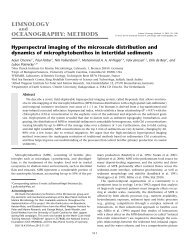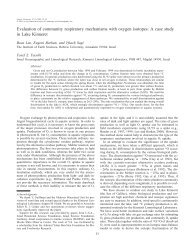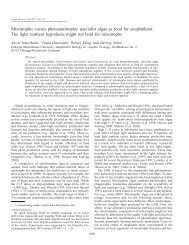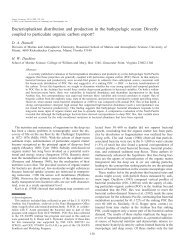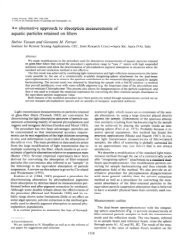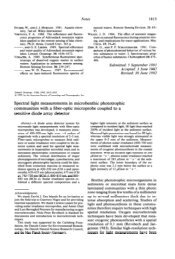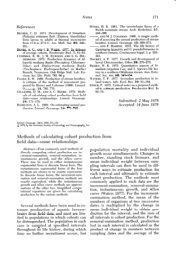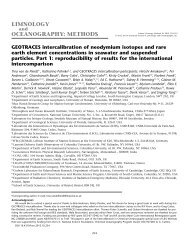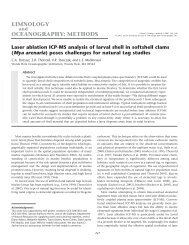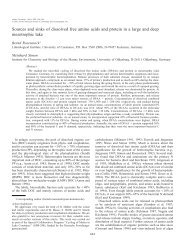Download - ASLO
Download - ASLO
Download - ASLO
You also want an ePaper? Increase the reach of your titles
YUMPU automatically turns print PDFs into web optimized ePapers that Google loves.
od of calibrating that could be used in the field<br />
in the absence of the rotating arm apparatus.<br />
In quiescent solutions or solutions with very<br />
low forced convection rates, the density difference<br />
between the (saturated) liquid-solid interface<br />
and the bulk solution drives a convection<br />
current which is the principal mechanism<br />
that moves solution away from the solid. The<br />
natural and forced convection terms are in<br />
general not directly additive (Pei 1965; Churchill<br />
1977) in determining total convection or<br />
the dissolution rates.<br />
We suspended clod cards in quiescent solutions<br />
in ice chests under constant temperature<br />
conditions indoors. The ice chests supported<br />
dissolution rates roughly following Eq.<br />
4 over 4-6 d (Fig. 11A); Fig. 11 B correlates<br />
the natural convection ice-chest data. The<br />
equation fitting the data is<br />
[ 1 - ( W,lWi)1’3]/8<br />
= 2.81 ($)[(&)(+L.,,] 1.25 (10)<br />
with r = 0.994.<br />
Equations 8 and 10 can be combined to<br />
give an expression that will allow an equivalent<br />
integrated velocity to be determined from<br />
data obtained in the field. The group Sn =<br />
[ 1 - (~~ Wi)“]lB is obtained in natural convection<br />
clod card tests with water from the<br />
field test site. Weight loss data from cards exposed<br />
to water motion in the field is reduced<br />
to a corresponding form:<br />
Then the integrated<br />
calculated as<br />
Sf = [ 1 - ( Wr/ Wi)“]/8-<br />
water speed in the field is<br />
I/= 4.31(5=(y). (11)<br />
S’.25/Sn is similar to DF (Doty 197 1) but should<br />
be superior as an indicator of water motion in<br />
that it corrects for the effects of decreasing surface<br />
area during the tests and the greater effect<br />
of forced convection in producing dissolution<br />
relative to free convection (the 1.25 exponent<br />
for S&<br />
If field tests are conducted in water with lim-<br />
12<br />
'; 0.03<br />
0<br />
3<br />
?<br />
-y 0.02<br />
c<br />
r'<br />
Y<br />
C<br />
a ~0~/6.,25~C,n=Z<br />
. 25 3.. 16.5-C<br />
Time, d<br />
0.04<br />
, 0 Tap<br />
0 20 '/..<br />
0.01<br />
0.01<br />
0.02<br />
(T/T~~)&/P) AC250 mol Ihr-'<br />
A .<br />
Fig. 11. Free convection data obtained by suspending<br />
clod cards in large volumes of quiescent solutions in ice<br />
chests (A), and (B) correlation of the data using Eq. 8 at<br />
T,, = 298°K (25°C).<br />
ited motion, say V < 2 cm s-l, Eq. 11 will<br />
give erroneous results because free convection<br />
forces can also produce dissolution in the field.<br />
If it is necessary to separate the forced and free<br />
convection effects, multiply the right-hand side<br />
of Eq. 11 by [ 1 - (SJSf)3]5/12. This is a rough<br />
correction derived from Churchill (1977) for<br />
heat transfer with assisting forced and free convection.<br />
Many of the applications for clod cards involve<br />
measurement of unsteady flow, ranging<br />
from wind waves to oscillatory tidal currents.<br />
The methods presented here will indicate an<br />
integrated average speed near the scalar arithmetic<br />
mean velocity of the water because<br />
[ 1 - ( Wj &)“I/8 is nearly linear with velocity<br />
(actually Ve8). For example, if the water velocity<br />
over the card varies linearly from V, at<br />
time zero to V, at time 8, Eq. 1 and 2 can be<br />
used with the mass transfer coefficient from<br />
Eq. 8 to derive the expression<br />
0.03




